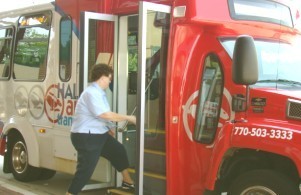According to figures supplied by the Gainesville-Hall County Community Service Center, the agency through which the Red Rabbit is administered, the service, which began Jan. 22, 2001, started with four routes, four buses operating daily, 108 bus stops, nine full-time drivers, five part-time drivers, and during its first full fiscal year of operation carried 40,647 passengers.
By the of the last fiscal year, the number of routes had grown to seven, the number of buses operating daily had increased to nine, the number of bus stop to 200, the number of full-time drivers to 10, and part-time to 17. The number of passengers had increased by 101,883 to 142,530.
Fares have remained the same since the system began operation, according to Phillippa Lewis-Moss, director of the community service center, at 50 cents for students and seniors and $1.00 for others.
Fares are generating about $60,000 a year in income, according to Lewis-Moss, with the bulk of the revenue for the operation of the system coming from state and federal grants, supplemented by the Gainesville City Council and Hall County Board of Commissioners.
That breaks down this way, according to Lewis-Moss:
*City of Gainesville - $86,000 the first year; $173,000 last year
*Hall County - $86,000 the first year; $173,000 last year
*State/federal funds - $172,000 the first year; $411,000 last year.
The total operating budget has increased from $344,000 to $823,000.
Does the Red Rabbit break even? No, says Lewis-Moss.
Does it make money? No, she says.
Lewis-Moss says there is not a public transit system in the country that makes money. The Las Vegas system, one of the most successful in the country because of the sheer number of riders it has for its size, was the last to record more income than expenses but that was several years ago.
Do yearly expenses ever exceed income? No, she says, because, by federal law, expenses cannot exceed income and income vs. expenses is carefully monitored through monthly reports to the federal agencies that oversee the system's operation. Lewis-Moss says the rules and regulations that govern the operation of the Red Rabbit and all the paperwork and record-keeping that go with them are her biggest challenge.
What happens if, with several months left in a fiscal year, it is apparent that expenses are going to top income? Cut backs, she says, in the number of trips, hours worked by employees, etc.
The most popular route is Route 5, the one that serves the major shopping districts on the west side of town - Lakeshore Mall, Wal-Mart, and the retail centers in the Dawsonville Highway/McEver Road area.
(EDITOR'S NOTE: This is the first in a series of special reports this week on Gainesville's Red Rabbit, the fixed-route bus system operated since Jan. 22, 2001, by the Gainesville-Hall County Community Service Center. Future reports will look at the justification for its continued existence, including what one of its most persistent critics has had to say about it through the years, and the future of the system.)

Ridership on the Red Rabbit has grown over the past 10 years from 40,647 to 142,530.
http://accesswdun.com/article/2011/1/235542
